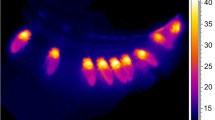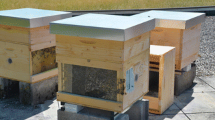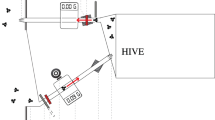Summary
We experimentally tested whether foraging strategies of nectar-collecting workers of the honeybee (Apis mellifera) vary with colony state. In particular, we tested the prediction that bees from small, fast growing colonies should adopt higher workloads than those from large, mature colonies. Queenright “small” colonies were set up by assembling 10 000 worker bees with approximately 4100 brood cells. Queenright “large” colonies contained 35 000 bees and some 14 500 brood cells. Thus, treatments differed in colony size but not in worker/brood ratios. Differences in workload were tested in the context of single foraging cycles. Individuals could forage on a patch of artificial flowers offering given quantities and qualities of nectar rewards. Workers of small colonies took significantly less nectar in an average foraging excursion (small: 40.1 ± 1.1 SE flowers; large: 44.8 ± 1.1), but spent significantly more time handling a flower (small: 7.3 ± 0.4 s ; large: 5.8 ± 0.4 s). When the energy budgets for an average foraging trip were calculated, individuals from all colonies showed a behavior close to maximization of net energetic efficiency (i.e., the ratio of net energetic gains to energetic costs). However, bees from small colonies, while incurring only marginally smaller costs, gained less net energy per foraging trip than those from large colonies, primarily as a result of prolonged handling times. The differences between treatments were largest during the initial phases of the experimental period when also colony development was maximally different. Our results are at variance with simple models that assume natural selection to have shaped behavior in a single foraging trip only so as to maximize colony growth.
Similar content being viewed by others
References
Allen MD, Jeffree EP (1956) The influence of stored pollen and of colony size on the brood rearing of honeybees. Ann Appl Biol 44:649–656
Bourke AFG (1988) Worker reproduction in the higher eusocial hymenoptera. Q Rev Biol 63:291–311
Brian MV (1953) Brood rearing in relation to worker number in the ant Myrmica. Physiol Zool 26:355–366
Brian MV (1966) Inefficiency in brood-rearing in the ant Myrmica rubra L. Insectes Soc 3:71–74
Brian MV (1983) Social insects. Chapman and Hall, London
Cole BJ (1984) Colony efficiency and the reproductivity effect in Leptothorax allardycei (Mann). Insectes Soc 31:403–407
Eischen FA, Rothenbuhler WC, Kulinevic JM (1982) Length of life and dry weight of worker honeybees reared in colonies with different worker-larvae ratios. J Apic Res 21:19–25
Fritz RS, Morse DH (1985) Reproduction success and foraging of the crab spider Misumena vatia. Oecologia 65:194–200
Heinrich B (1979) Bumblebee economics. Harvard University Press, Cambridge
Houston AI, McNamara JM (1986) The influence of mortality on the behaviour that maximizes reproductive success in a patchy environment.
Houston AI, Schmid-Hempel P, Kacelnik A (1988) Colony growth, worker mortality and foraging strategy in social insects. Am Nat 131:107–114
Jeffree EP, Allen MD (1956) The influence of colony size and Nosema disease on the rate of population loss in honeybee colonies in winter. J Econ Entomol 49:831–843
Kolmes S, Winston ML (1988) Division of labor among worker honey bees in demographically manipulated colonies. Insectes Soc 35:262–270
Lee PC, Winston ML (1985a) The influence of swarm size on brood production and emergent worker weight in newly founded honey bee colonies (Apis mellifera L.). Insectes Soc 32:96–103
Lee PC, Winston ML (1985b) The effect of swarm size and date of issue on comb construction in newly founded colonies of honeybees (Apis mellifera). Can J Zool 63:524–527
Litte M (1979) Mischocyttarus flavipes in Arizona: social and nesting biology of a polistine wasp. Z Tierpsychol 50:282–312
McLellan AR, Rowland RW, Fawell RH (1980) A monogynous eusocial insect worker population model with particular reference to honeybees. Insectes Soc 27:305–311
Michener CD (1964) Reproductive efficiency in relation to colony size in hymenopterous societies. Insectes Soc 11:317–341
Morse DH (1986) Predatory risk to insects foraging at flowers. Oikos 46:223–228
Neukirch A (1982) Dependence of life span of the honeybee (Apis mellifera) upon flight performance and energy consumption. J Comp Physiol 146:35–40
Nonacs P, Dill LM (1988) Foraging response of the ant Lasius pallitarsis to food sources with associated mortality risks. Insectes Soc 35:293–303
Oster GF, Wilson EO (1978) Caste and ecology in the social insects. Princeton University Press, Princeton
Pomeroy N (1979) Brood bionomics of Bombus ruderatus in New Zealand (Hymenoptera: Apidae). Can Entomol 111:865–874
Richards OW, Richards WJ (1951) Observations on the social wasps of South America (Hymenoptera, Vespidae). Trans R Entomol Soc London 102:1–170
Rothe U, Nachtigall W (1989) Flight of the honeybee. IV. Respiratory quotients and metabolic rates during sitting, walking and flying. J Comp Physiol (B) 158:739–749
Schmid-Hempel P (1987) Efficient nectar-collection by honeybees. I. Economic models. J Anim Ecol 56:209–218
Schmid-Hempel P (1990) Reproductive competition and the evolution of work load in social insects. Am Nat 135:501–525
Schmid-Hempel P, Schmid-Hempel R (1988) Parasitic flies (Conopidae, Diptera) may be important stress factors for the ergonomics of their bumblebee hosts. Ecol Entomol 13:469–472
Schmid-Hempel P, Wolf T (1988) Foraging effort and life span of workers in a social insect. J Anim Ecol 57:509–521
Schmid-Hempel P, Kacelnik A, Houston AI (1985) Honeybees maximize efficiency by not filling their crop. Behav Ecol Sociobiol 17:61–66
Seeley TD (1982) Adaptive significance of the age polyethism schedule in honeybee colonies. Behav Ecol Sociobiol 11:287–293
Seeley TD (1985) Honeybee ecology. Princeton University Press, Princeton
Seeley TD (1986) Social foraging by honeybees: how colonies allocate foragers among patches of flowers. Behav Ecol Sociobiol 19:343–354
Seeley TD (1989) Social foraging in honeybees: how nectar foragers assess their colony's nutritional status. Behav Ecol Sociobiol 24:181–189
Seeley TD, Visscher PK (1985) Survival of honeybees in cold climates: the critical timing of colony growth and reproduction. Ecol Entomol 10:81–88
Severin HC (1937) Zodion fulvifrons Say (Diptera: Conopidae), a parasite of the honeybee. Entomol News 48:243–244
Stearns SC, Schmid-Hempel P (1987) Evolutionary insights should not be wasted. Oikos 49:118–125
Wilson EO (1971) The insect societies. Harvard University Press, Cambridge
Wilson EO (1984) The relation between caste ratios and division of labor in the ant genus Pheidole (Hymenoptera: Formicidae). Behav Ecol Sociobiol 16:89–98
Winston ML (1987) The biology of the honey bee. Harvard University Press, Cambridge
Winston ML, Fergusson LA (1985) The effect of worker loss on temporal caste structure in colonies of the honeybee (Apis mellifera). Can J Zool 63:777–780
Winston ML, Punnett EN (1982) Factors determining temporal division of labor in honeybees. Can J Zool 60:2947–2952
Wolf TJ, Schmid-Hempel P (1989) Extra loads and foraging life span in honeybee workers. J Anim Ecol 58:943–954
Wolf TJ, Schmid-Hempel P, Ellington CP, Stevenson RD (1989) Physiological correlates of foraging efforts in honeybees: oxygen consumption and nectar load. Funct Ecol 3:417–424
Zar JH (1984) Biostatistical analysis. Prentice-Hall, Englewood Cliffs NJ
Author information
Authors and Affiliations
Additional information
Offprint requests to: P. Schmid-Hempel
Rights and permissions
About this article
Cite this article
Wolf, T.J., Schmid-Hempel, P. On the integration of individual foraging strategies with colony ergonomics in social insects: nectar-collection in honeybees. Behav Ecol Sociobiol 27, 103–111 (1990). https://doi.org/10.1007/BF00168453
Received:
Accepted:
Issue Date:
DOI: https://doi.org/10.1007/BF00168453




